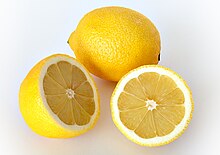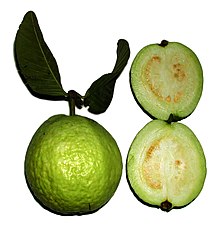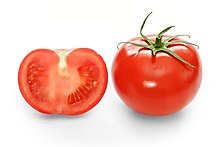Pulp
Pulp is the juicy tissue in fruits with a high water content (so-called juice fruits ) in which a seed or several seeds are embedded. Together with seeds, remains of the flower and a skin or peel, it forms the fruit . The pulp helps the seeds to spread better . The pulp of the various fruits and vegetables plays an important role in the diet .
ecology
In order for plants to be able to spread their seeds over a longer distance, they often depend on animals . They surround the often indigestible seeds with tasty and nutritious pulp. The animals eat the fruit with the seeds and excrete them undigested at a more remote location. In this way, the corresponding plant species spread faster.
In contrast to the nut , where the seed is the actual food for the animals, it is unintentionally eaten with fruits with pulp. This has the advantage that fewer seeds have to be produced by the plant for the same number of common seeds, since not only the seeds forgotten and lost as a reserve can germinate. Often there are also no hard shells that protect the seeds and can only be cracked by nutrition specialists. On the contrary, the pulp attracts many animal species and thus contributes to the spread. When the seed is excreted with the feces , it is immediately surrounded by a substrate with many nutrients . In the case of stone fruits , which are mostly eaten by birds, the pulp is detached from the core with the beak and only this is digested , but the core is simply dropped.
Pulp and related names




Synonyms for pulp
In botany, the pulp of some fruits is also referred to as pulp , including citrus fruits and bananas or the fruit of the sea buckthorn . In the case of citrus fruits, the fruit is designed as a so-called endocarp berry or armored berry; Linnaeus used the term " hesperidium ".
The Germanized word form pulp is mainly used outside of systematic botany, for example in food science, as a term for the pulp of some fruits, including coffee , cocoa and Hylocereus triangularis .
The term pulp is also used in the production of fruit juices. When squeezing oranges, the raw orange juice (raw juice) still contains crushed solid components of the pulp. After sieving this “pulp”, clear juice remains. For juices that are offered as "orange juice with pulp", pulp was added again before filling.
The word form pulp is also known in kitchen language . According to the New Kitchen Encyclopedia , it is used to describe dug out pulp.
Occasionally, instead of pulp, the descriptive term fruit pulp is used, for example with cocoa. But should be noted that fruit pulp (also briefly pulp or pulp ) (. Eg jam Regulation) in the food industry and in the food law a term for a defined semi-finished product in the fruit processing is: fruit pulp in this sense is a mixture of pieces of fruit and porridge processed pulp.
If the consistency is appropriate, the term fruit pulp is also used for some plants , especially cocoa.
Differentiation between pulp and pulp
Often an inner, softer area can be seen within the pulp that immediately surrounds the seeds. With some fruits like the guava or the prickly pear cactus , the different areas are also linguistically differentiated: The outer area is the pulp , the inner area is called pulp or pulp .
In the case of the cucumber or the tomato , different areas can be distinguished in the ripe fruits: Comparatively firm outer pulp surrounds a softer area in which the seeds are embedded. Nevertheless, it is simply summarized in cucumbers, tomatoes and most other fruits of pulp spoken - the term pulp or pulp is not common in many fruits, not as a synonym for pulp different even to distinguish portions of the flesh.
Origin of words and meaning transfers
Latin pulpa actually means "meat". The Latin foreign word pulp not only describes the pulp of some fruits, but also the tooth pulp and various functional tissues in the spleen (white and red spleen pulp) in anatomy. The word form pulp was still used in anatomy in the 19th century. Today it is no longer used in the singular - but rather as a plural form of pulps and compositions . For example, the term pulp tissue is just as common in medicine and dentistry as pulp tissue .
The three eingedeutschten word forms pulp, pulp and pulp are all from latin pulpa from, the mold Pulp was mediated from English to German and the shape of the pulp of French pulp is derived. Based on the meaning of "pulp or fleshy parts of the plant", pulp, pulp and pulp became names for various pulpy and / or fibrous masses that arise during processing, see pulp (processing technology) .
For English pulp the meaning “pulp or flesh part of a plant” can be traced back to around 1400; the use of the term pulp for various similar substances began as early as the early 15th century.
Web links
Individual evidence
- ↑ Fruchtfleisch in the Lexikon der Biologie, Spektrum.de
- ^ Pulp in the Lexicon of Biology, Spektrum.de. See the mention of pulp in the article banana plants .
- ↑ Reinhard Lieberei, Christoph Reisdorff: Nutzpflanzenkunde . Thieme, 2007, p. 196 .
- ↑ Citrus Botanical Gardens of the University of Bonn
- ↑ Example for the word form pulp in coffee: What is the pulp? tchibo.de/kaffeelexikon
- ↑ Example for the word form pulp in coffee: raw coffee food dictionary.de
- ↑ Example for the word form pulp for cocoa: No OTA in fresh cocoa beans Food chemistry institute of the Federal Association of the German Confectionery Industry
- ↑ Example for the word form pulp for cocoa: The cocoa fruit information center chocolate
- ↑ Dietmar Brandes (2008): Markt-Botanik - Botanical excursions over markets (PDF), p. 78 (Pulp at Hylocereus triangularis ).
- ↑ Background: Apple and orange juice , in: Schrot & Korn , January 2007.
- ↑ The new kitchen encyclopedia , keyword pulp . Quote: "In the kitchen, dug pulp (also from potatoes) is often referred to as pulp."
- ↑ Example of the term fruit pulp in cocoa: Valuable beans from Central America br.de
- ↑ pulp, fruit pulp, fruit pulp lebensmittellexikon.de
- ↑ Information sheet cocoa klett.de
- ↑ The Cocoa Fruit Info Center Chocolate
- ^ Food. The whole world of food . Teubner (Graefe and Unzer), 2011, p. 169. Quotation on greenish-white guavas: "Their firm, juicy pulp surrounds the pulp with the kernels."
- ↑ K. Herrmann: Exotic food: Ingredients and use. For biologists, chemists, medical professionals and amateur cooks , Springer-Verlag, 2013, p. 28. Quote: The vitamin C content of guava fruit “is significantly higher in the outer flesh of the fruit than in the inner pulp”.
- ↑ Sabine Krist: Lexicon of vegetable fats and oils , Springer-Verlag, 2nd edition 2012, p. 324. Quotation on the prickly pear: “The juicy flesh underneath [= under the skin] is about 1 cm thick. The pulp inside encloses the numerous black seeds ... "
- ↑ Example: Better capping in deep lesions zwp-online.info, August 10, 2015. The plural form pulps occurs frequently in this specialist text .
- ↑ Duden : Die deutsche Rechtschreibung , 25th edition (2009), keyword Pulp .
- ↑ a b English pulp in the Online Etymology Dictionary
